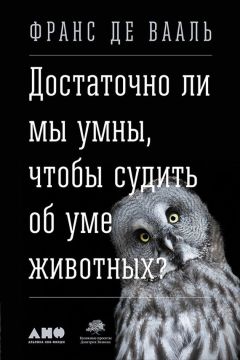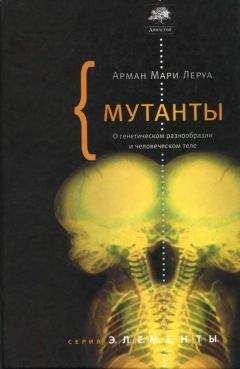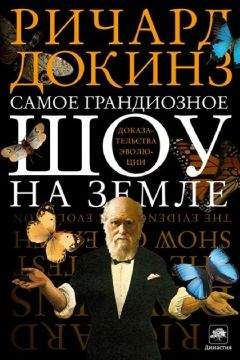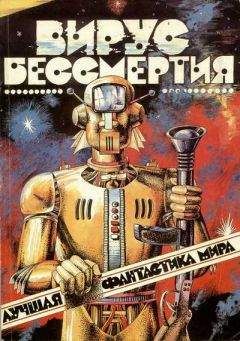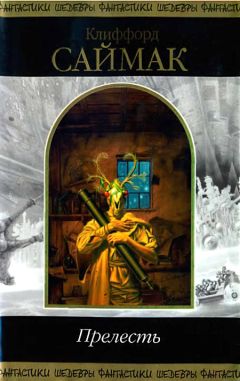Библиография
Adler, J. 2008. Thinking like a monkey. Smithsonian Magazine, January. Aitchison, J. 2000. The Seeds of Speech: Language Origin and Evolution, Cambridge, UK: Cambridge University Press.
Alexander, M. G., and T. D. Fisher. 2003. Truth and consequences: Using the bogus pipeline to examine sex differences in self-reported sexuality. Journal of Sex Research 40:27–35.
Allen, B. 1997. The chimpanzee's tool. Common Knowledge 6:34–51.
Allen, J., M. Weinrich, W. Hoppitt, and L. Rendell. 2013. Network-based diffusion analysis reveals cultural transmission of lobtail feeding in humpback whales. Science 340:485–88.
Anderson, J. R., and G. G. Gallup. 2011. Which primates recognize themselves in mirrors? Plos Biology 9: e1001024.
Anderson, R. C., and J. A. Mather. 2010. It's all in the cues: Octopuses (Enter octopus dof leini) learn to open jars. Ferrantia 59:8–13.
Anderson, R. C., J. A. Mather, M. Q. Monette, and S. R. M. Zimsen. 2010. Octopuses (Enteroctopus dof leini) recognize individual humans. Journal of Applied Animal Welfare Science 13:261–72.
Anderson, R. C., J. B. Wood, and R. A. Byrne. 2002. Octopus senescence: The beginning of the end. Journal of Applied Animal Welfare Science 5:275–83. Aristotle. 1991. History of Animals, trans. D. M. Balme. Cambridge, MA: Harvard University Press.
Arnold, K., and K. Zuberbühler. 2008. Meaningful call combinations in a nonhuman primate. Current Biology 18: R202–3.
Auersperg, A. M. I., B. Szabo, A. M. P. Von Bayern, and A. Kacelnik. 2012. Spontaneous innovation in tool manufacture and use in a Goffin's cockatoo. Current Biology 22: R903–4.
Aureli, F., R. Cozzolinot, C. Cordischif, and S. Scucchi. 1992. Kin-oriented redirection among Japanese macaques: An expression of a revenge system? Animal Behaviour 44:283–91.
Azevedo, F. A. C., et al. 2009. Equal numbers of neuronal and nonneuronal cells make the human brain an isometrically scaled-up primate brain. Journal of Comparative Neurology 513:532–41.
Babb, S. J., and J. D. Crystal. 2006. Episodic-like memory in the rat. Current Biology 16:1317–21.
Ban, S. D., C. Boesch, and K. R. L. Janmaat. 2014. Taï chimpanzees anticipate revisiting high-valued fruit trees from further distances. Animal Cognition 17:1353–64.
Barton, R. A. 2012. Embodied cognitive evolution and the cerebellum. Philosophical Transactions of the Royal Society B 367:2097–107.
Bates, L. A., et al. 2007. Elephants classify human ethnic groups by odor and garment color. Current Biology 17:1938–42.
Baumeister, R. F. 2008. Free will in scientific psychology. Perspectives on Psychological Science 3:14–19.
Beach, F. A. 1950. The snark was a boojum. American Psychologist 5:115–24. Beck, B. B. 1967. A study of problem-solving by gibbons. Behaviour 28: 95–109.
–. 1980. Animal Tool Behavior: The Use and Manufacture of Tools by Animals. New York: Garland STPM Press.
–. 1982. Chimpocentrism: Bias in cognitive ethology. Journal of Human Evolution 11:3–17.
Bekoff, M., and C. Allen. 1997. Cognitive ethology: Slayers, skeptics, and proponents. In Anthropomorphism, Anecdotes, and Animals: The Emperor's New Clothes? ed. R. W. Mitchell, N. Thompson, and L. Miles, 313–34. Albany: SUN Y Press.
Bekoff, M., and P. W. Sherman. 2003. Ref lections on animal selves. Trends in Ecology and Evolution 19:176–80.
Bekoff, M., C. Allen, and G. M. Burghardt, eds. 2002. The Cognitive Animal: Empirical and Theoretical Perspectives on Animal Cognition. Cambridge, MA: Bradford.
Beran, M. J. 2002. Maintenance of self-imposed delay of gratification by four chimpanzees (Pan troglodytes) and an orangutan (Pongo pygmaeus). Journal of General Psychology 129:49–66.
–. 2015. The comparative science of "self-control": What are we talking about? Frontiers in Psychology 6:51.
Berns, G. S. 2013. How Dogs Love Us: A Neuroscientist and His Adopted Dog Decode the Canine Brain. Boston: Houghton Miff lin.
Berns, G. S., A. Brooks, and M. Spivak. 2013. Replicability and heterogeneity of awake unrestrained canine f MRI responses. Plos ONE 8: e81698.
Bird, C. D., and N. J. Emery. 2009. Rooks use stones to raise the water level to reach a f loating worm. Current Biology 19:1410–14.
Bischof-Köhler, D. 1991. The development of empathy in infants. In Infant Development: Perspectives From German-Speaking Countries, ed. M. Lamb and M. Keller, 245–73. Hillsdale, NJ: Erlbaum.
Bjorklund, D. F., J. M. Bering, and P. Ragan. 2000. A two-year longitudinal study of deferred imitation of object manipulation in a juvenile chimpanzee (Pan troglodytes) and orangutan (Pongo pygmaeus). Developmental Psychobiology 37:229–37.
Boesch, C. 2007. What makes us human? The challenge of cognitive cross-species comparison. Journal of Comparative Psychology 121:227–40.
Boesch, C., and H. Boesch-Achermann. 2000. The Chimpanzees of the Taï Forest: Behavioural Ecology and Evolution. Oxford: Oxford University Press.
Boesch, C., J. Head, and M. M. Robbins. 2009. Complex tool sets for honey extraction among chimpanzees in Loango National Park, Gabon. Journal of Human Evolution 56:560–69.
Bolhuis, J. J., and C. D. L. Wynne. 2009. Can evolution explain how minds work? Nature 458:832–33.
Bonnie, K. E., and F. B. M. de Waal. 2007. Copying without rewards: Socially inf luenced foraging decisions among brown capuchin monkeys. Animal Cognition 10: 283–92.
Bonnie, K. E., V. Horner, A. Whiten, and F. B. M. de Waal. 2006. Spread of arbitrary conventions among chimpanzees: A controlled experiment. Proceedings of the Royal Society of London B 274:367–72.
Bovet, D., and D. A. Washburn. 2003. Rhesus macaques categorize unknown conspecifics according to their dominance relations. Journal of Comparative Psychology 117:400–5.
Boyd, R. 2006. The puzzle of human sociality. Science 314:1555–56.
Boysen, S. T., and G. G. Berntson. 1989. Numerical competence in a chimpanzee (Pan troglodytes). Journal of Comparative Psychology 103:23–31.
–. 1995. Responses to quantity: Perceptual versus cognitive mechanisms in chimpanzees (Pan troglodytes). Journal of Experimental Psychology: Animal Behavior Processes 21:82–86.
Bramlett, J. L., B. M. Perdue, T. A. Evans, and M. J. Beran. 2012. Capuchin monkeys (Cebus apella) let lesser rewards pass them by to get better rewards. Animal Cognition 15:963–69.
Bräuer, J., et al. 2006. Making inferences about the location of hidden food: Social dog, causal ape. Journal of Comparative Psychology 120: 38–47.
Bräuer, J., and J. Call. 2015. Apes produce tools for future use. American Journal of Primatology 77:254–63.
Breland, K., and M. Breland. 1961. The misbehavior of organisms. American Psychologist 16:681–84.
Breuer, T., M. Ndoundou-Hockemba, and V. Fishlock. 2005. First observation of tool use in wild gorillas. Plos Biology 3:2041–43.
Brosnan, S. F., et al. 2010. Mechanisms underlying responses to inequitable outcomes in chimpanzees. Animal Behaviour 79:1229–37.
Brosnan, S. F., and F. B. M. de Waal. 2003. Monkeys reject unequal pay. Nature 425:297–99.
–. 2014. The evolution of responses to (un) fairness. Science 346:1251776. Brosnan, S. F., C. Freeman, and F. B. M. de Waal. 2006. Partner's behavior, not
reward distribution, determines success in an unequal cooperative task in capuchin monkeys. American Journal of Primatology 68:713–24.
Brown, C., M. P. Garwood, and J. E. Williamson. 2012. It pays to cheat: Tactical deception in a cephalopod social signalling system. Biology Letters 8:729–32. Browning, R. 2006 [orig. 1896]. The Poetical Works. Whitefish, MT: Kessinger. Bruck, J. N. 2013. Decades-long social memory in bottlenose dolphins. Proceedings of the Royal Society B 280: 20131726.
Bshary, R., and R. Noë. 2003. Biological markets: The ubiquitous inf luence of partner choice on the dynamics of cleaner fish-client reef fish interactions. In Genetic and Cultural Evolution of Cooperation, ed. P. Hammerstein, 167–84. Cambridge, MA: MIT Press.
Bshary, R., A. Hohner, K. Ait-El-Djoudi, and H. Fricke. 2006. Interspecific communicative and coordinated hunting between groupers and giant moray eels in the Red Sea. Plos Biology 4: e431.
Buchsbaum, R., M. Buchsbaum, J. Pearse, and V. Pearse. 1987. Animals Without Backbones: An Introduction to the Invertebrates. 3rd ed. Chicago: University of Chicago Press.
Buckley, J., et al. 2010. Biparental mucus feeding: A unique example of parental care in an Amazonian cichlid. Journal of Experimental Biology 213:3787–95.
Buckley, L. A., et al. 2011. Too hungry to learn? Hungry broiler breeders fail to learn a y-maze food quantity discrimination task. Animal Welfare 20: 469–81. Bugnyar, T., and B. Heinrich. 2005. Ravens, Corvus corax, differentiate between knowledgeable and ignorant competitors. Proceedings of the Royal Society of London B 272:1641–46.
Burghardt, G. M. 1991. Cognitive ethology and critical anthropomorphism: A snake with two heads and hognose snakes that play dead. In Cognitive Ethology: The Minds of Other Animals: Essays in Honor of Donald R. Griffin, ed. C. A. Ristau, 53–90. Hillsdale, NJ: Lawrence Erlbaum Associates.
Burkhardt, R. W. 2005. Patterns of Behavior: Konrad Lorenz, Niko Tinbergen, and the Founding of Ethology. Chicago: University of Chicago Press.
Burrows, A. M., et al. 2006. Muscles of facial expression in the chimpanzee (Pan troglodytes): Descriptive, ecological and phylogenetic contexts. Journal of Anatomy 208:153–68.
Byrne, R. 1995. The Thinking Ape: The Evolutionary Origins of Intelligence. Oxford: Oxford University Press.
Byrne, R., and A. Whiten. 1988. Machiavellian Intelligence. Oxford: Oxford University Press.
Calcutt, S. E., et al. 2014. Captive chimpanzees share diminishing resources. Behaviour 151:1967–82.
Caldwell, C. C., and A. Whiten. 2002. Evolutionary perspectives on imitation: Is a comparative psychology of social learning possible? Animal Cognition 5:193–208.
Call, J. 2004. Inferences about the location of food in the great apes. Journal of Comparative Psychology 118:232–41.
–. 2006. Descartes' two errors: Reason and ref lection in the great apes. In Rational Animals, ed. S. Hurley and M. Nudds, 219–234. Oxford: Oxford University Press.
Call, J., and M. Carpenter. 2001. Do apes and children know what they have seen? Animal Cognition 3:207–20.
Call, J., and M. Tomasello. 2008. Does the chimpanzee have a theory of mind? 30 Years Later. Trends in Cognitive Sciences 12:187–92.
Callaway, E. 2012. Alex the parrot's last experiment shows his mathematical genius. Nature News Blog, Feb. 20, http://bit.ly / 1eYgqoD.
Calvin, W. H. 1982. Did throwing stones shape hominid brain evolution? Ethology and Sociobiology 3:115–24.
Candland, D. K. 1993. Feral Children and Clever Animals: Reflections on Human Nature. New York: Oxford University Press.
Cenami Spada, E., F. Aureli, P. Verbeek, and F. B. M. de Waal. 1995. The self as reference point: Can animals do without it? In The Self in Infancy: Theory and Research, ed. P. Rochat, 193–215. Amsterdam: Elsevier.
Chang, L., et al. 2015. Mirror-induced self-directed behaviors in rhesus monkeys after visual-somatosensory training. Current Biology 25:212–17.
Cheney, D. L., and R. M. Seyfarth. 1986. The recognition of social alliances by vervet monkeys. Animal Behaviour 34 (1986): 1722–31.
–. 1989. Redirected aggression and reconciliation among vervet monkeys, Cercopithecus aethiops. Behaviour 110: 258–75.
–. 1990. How Monkeys See the World: Inside the Mind of Another Species. Chicago: University of Chicago Press.
Claidière, N., et al. 2015. Selective and contagious prosocial resource donation in capuchin monkeys, chimpanzees and humans. Scientific Reports 5:7631. Clayton, N. S., and A. Dickinson. 1998. Episodic-like memory during cache recovery by scrub jays. Nature 395:272–74.
Corballis, M. C. 2002. From Hand to Mouth: The Origins of Language. Princeton, NJ: Princeton University Press.
–. 2013. Mental time travel: A case for evolutionary continuity. Trends in Cognitive Sciences 17:5–6.
Corbey, R. 2005. The Metaphysics of Apes: Negotiating the Animal-Human Boundary. Cambridge: Cambridge University Press.
Correia, S. P. C., A. Dickinson, and N. S. Clayton. 2007. Western scrub-jays anticipate future needs independently of their current motivational state. Current Biology 17:856–61.
Courage, K. H. 2013. Octopus! The Most Mysterious Creature in the Sea. New York: Current.
Crawford, M. 1937. The cooperative solving of problems by young chimpanzees. Comparative Psychology Monographs 14:1–88.
Crockford, C., R. M. Wittig, R. Mundry, and K. Zuberbühler. 2012. Wild chimpanzees inform ignorant group members of danger. Current Biology 22:142–46.
Csányi, V. 2000. If Dogs Could Talk: Exploring the Canine Mind. New York: North Point Press.
Cullen, E. 1957. Adaptations in the kittiwake to cliff-nesting. Ibis 99:275–302. Darwin, C. 1982 [orig. 1871]. The Descent of Man, and Selection in Relation to Sex. Princeton, NJ: Princeton University Press.
Davila Ross, M., M. J. Owren, and E. Zimmermann. 2009. Reconstructing the evolution of laughter in great apes and humans. Current Biology 19:1106–11.
de Groot, N. G., et al. 2010. AIDS-protective HLA-B*27 / B*57 and chimpanzee MHC class I molecules target analogous conserved areas of HIV-1 / SIVcpz. Proceedings of the National Academy of Sciences, USA 107:15175–80.
